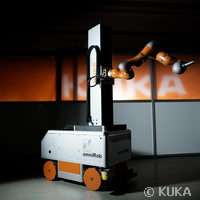Mobile robot to boost aerospace production

We don't have to look too far into the future to see a time when mobile robots and people will be working side-by-side in production facilities. In fact, for the aerospace manufacturing industry, this scenario could be a reality in just a few short years.
The EU-funded project VALERI ('Validation of Advanced, Collaborative Robotics for Industrial Applications') is currently engineering a mobile robot that operates autonomously and moves independently through a production hall. It works side-by-side with the engineers and technicians, relieving them of stressful and monotonous duties and taking over inspection duties.
The VALERI robot would help address industrial challenges in aerospace production. Currently, the production of large parts is stationary and the assembly takes days to complete.
The VALERI project's robot or 'mobile manipulator' aims to reduce this lengthy process by assisting human workers in applying sealant along grooves; inspecting sealant for quality control and inspecting braided carbon fiber parts. Technical workers can then install, drill, and test.
Coordinated by Fraunhofer Institute for Factory Operation and Automation (IFF), the project also involves Airbus DS, FACC AG, IDPSA, Prodintec, as well as KUKA Laboratories GmbH and Profactor GmbH.
Partners are well progressed through the project's seven work packages (WPs). They first defined their component specifications and then quickly completed a working laboratory prototype (by the end of the first 12 months) of the individual components. The idea was to test them individually and then quickly integrate and test as a complete system.
Jos Saenz, head of project at IFF and coordinator of VALERI, notes that stationary robots are not suited for the assembly of unwieldy airplane components several meters in length. 'For example, the elements of an airplane fuselage are too large for them to be adapted to a conventional production robot. You cannot rotate or turn them so that the system can work on them. So, it has to be the other way around. The robot drives to the desired location in the airplane'.
Mobile systems are flexible, can be used at various stations, can move forward at various speeds, and are capable of performing delivery services - for example, they could retrieve tools for the technicians from a warehouse.
The prototype is scheduled to take its first test drive by the end of this year. The project will conclude in October 2015, and project partners are confident that by that time they will be conducting tests under real life conditions.
The VALERI partners predict that these mobile helpers will also be deployed in other industries such as shipbuilding or the production of wind turbines. Ultimately, they hope that their work will demonstrate the flexibility of mobile manipulators on multiple production lines and help to implement safe human-machine-collaboration on the shop floor.
More information: www.valeri-project.eu/
Provided by CORDIS




















